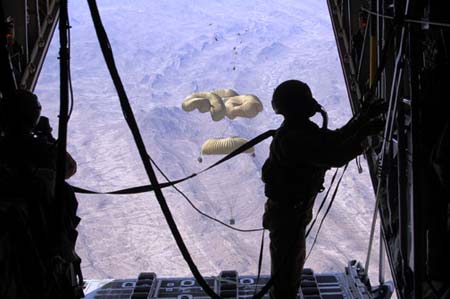According to  Air Forces Central, this year has seen a marked increase in the amount of supplies airdropped to US and coalition forces in Afghanistan and Iraq, already surpassing last year and three times the amount in 2006. This year so far USAF airmen have delivered via drops from C-130s and C-17s, more than 8.5 million pounds. AFCENT and 9th Air Force commander, Lt. Gen. Gary North, called the airdrop capability one of airpower’s “asymmetric advantages” throughout CENTCOM’s area of responsibility. He added, “In many places in Afghanistan, our airdrops are the sole source of resupply to ground forces” and enables “the collective forces to maintain the pressure on the enemy.” Maj. Andrew Purath, air mobility division tactics chief at the Combined Air and Space Operations Center, said that the increased presence of coalition forces at forward operating bases in Afghanistan has increased the demand for aerial resupply. “It has to be frustrating for an enemy to know that we can choose the time and place that we resupply our forces on the ground, particularly when the enemy must receive their supplies from overland sources in some of the most inaccessible real estate on the planet,” asserted Purath. He noted that, since 2004, combat airdrop operations have delivered a total of 19 million pounds with a 98.5 percent recovery rate. The current year’s total surpasses any single year since operations began in Afghanistan in 2001, said the major. (AFCENT report by SSgt. Andrea Thacker)
Air Forces Central, this year has seen a marked increase in the amount of supplies airdropped to US and coalition forces in Afghanistan and Iraq, already surpassing last year and three times the amount in 2006. This year so far USAF airmen have delivered via drops from C-130s and C-17s, more than 8.5 million pounds. AFCENT and 9th Air Force commander, Lt. Gen. Gary North, called the airdrop capability one of airpower’s “asymmetric advantages” throughout CENTCOM’s area of responsibility. He added, “In many places in Afghanistan, our airdrops are the sole source of resupply to ground forces” and enables “the collective forces to maintain the pressure on the enemy.” Maj. Andrew Purath, air mobility division tactics chief at the Combined Air and Space Operations Center, said that the increased presence of coalition forces at forward operating bases in Afghanistan has increased the demand for aerial resupply. “It has to be frustrating for an enemy to know that we can choose the time and place that we resupply our forces on the ground, particularly when the enemy must receive their supplies from overland sources in some of the most inaccessible real estate on the planet,” asserted Purath. He noted that, since 2004, combat airdrop operations have delivered a total of 19 million pounds with a 98.5 percent recovery rate. The current year’s total surpasses any single year since operations began in Afghanistan in 2001, said the major. (AFCENT report by SSgt. Andrea Thacker)
The U.S. began extensive air and artillery strikes against Islamic State group targets in Syria on Dec. 19 in retaliation for the killing of three Americans on Dec. 13 by a gunman affiliated with ISIS, U.S. officials said.

